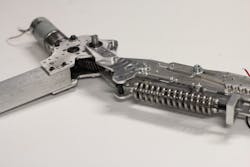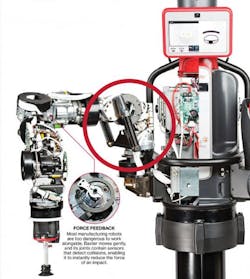Exclusive interview: Gill Pratt on how compliant actuators revolutionized robotics
When he was at the Massachusetts Institute of Technology Leg Lab in the 1990s, he developed compliant actuators known as series elastic actuators — SEAs — with his graduate student Matt Williamson. Since then, these mechanical devices have spurred a veritable revolution in robotic design and electronics.
Q: What are SEAs?
A: An SEA is a traditional motor-powered actuator fitted to a load with a spring in between. SEAs change the robotic-motion problem from one of positioning to one of force control.
Gearmotors, by far the most common actuator in robotics, are good position sources. But they’re inaccurate force sources because their gears exhibit variable friction, including stiction.
SEAs make for relatively cheap robotics by putting a spring after the geartrain and adding simple feedback controlling the spring’s amount of deflection. So for the low added cost of incorporating a spring, SEAs get high-fidelity force actuation, even if they’re built with inexpensive motors and gears.
Engineers can also design mobile robots with SEAs to interact with uncontrolled and unpredictable environments, or store some energy in the spring when it contacts the environment, and then release the energy afterwards.
Related Articles
Summary of all cobots — robots that work in close quarters with human beings
The rise of soft robots and the actuators that drive them
Technology forecast 2014: Robots priced for the masses
Q: Particularly in robotics, SEAs enable new designs because they impart compliance. But what specific problem were you trying to solve when you developed SEAs?
A: We were trying to develop walking robots. One of the questions was how we could build them to move through rough terrain without needing lots of software control. We wanted to simplify the problem by changing the mechanical design of the machine itself.
Major manufacturers focus on building sophisticated industrial robots for tasks such as machining, painting, and welding. These must be precise and stiff and hold position reliably. In contrast, tasks of scribing or grinding are better under force control, not position control. But the difficulty at the time was doing it inexpensively.
Q: Why didn’t existing robotic actuation work?
A: They just don’t adapt well when engineers try to apply them to jobs requiring them to move over rough terrain. That’s because many industrial robots are designed for either tightly controlled contact or no contact at all with the environment.
For example, on painting robots, the end tool doesn’t touch work surfaces. The same can be said of welding robots, though the end tool technically makes fluid contact with work surfaces.
In fact, we weren’t the only research engineers working on compliant force control. Such designs actually have a long history and have proved advantageous for a lot of tasks.
Q: Did you find any inspiration in the designs of nature?
A: Yes, we found inspiration in the design of animal legs, with muscles, tendons, and bones arranged to output soft motion and traverse a world with hard surfaces that dictate positions of contact with soft locomoting forms. To comply with the solid and unyielding environment, we must be soft. So, I figured we needed actuators that would automatically adjust to the location of objects in the world.
Think about it. Compliant actuators in nature are built to specific tasks. Human muscles connect to joints through relatively stiff tendons. In contrast, the Achilles tendons in kangaroo legs are far more compliant to store energy for efficient hops. Robotic designs have the same range of compliance. Some in traditional precision robots drive applications needing high-bandwidth position control. Others with lots of elasticity are quite soft to drive robots needing force control.
Q: Were there any other sources of inspiration?
A: I also found inspiration in mechanical analogs to switched-mode power supplies. I trained in electrical engineering and worked on designing switched-mode power supplies and inverters to drive motors for electric cars.
At the time, the old technology was voltage mode, in which a power supply puts out a certain voltage. But newer power supplies and motor drives used current mode, with an inner control loop generating a certain amount of current. Transmogrifying voltage and current into the mechanical world gives velocity and force.
Therefore, I thought we should do in the mechanical world what had been done in electronic design of power supplies. So we built an inexpensive SEA precursor with a spring in series, essentially closing an inner feedback loop on the amount of spring deflection.
To be clear, vector control of electric motors is the latest innovation in the motor-drive field. The technology that inspired me was for control of current in motor windings, which predates vector control. Perhaps in time we’ll see more equivalent advances in mechanical design.
Q: How safe are SEA-driven robots around people?
A: Besides their lower cost and efficiency, another advantage of SEAs is that they’re inherently safe to operate around people. Remember that a geartrain attached to a motor multiplies the effective inertia by the square of the gear ratio. Therefore, even small, high-speed motors with a safe inertia may need gearing to slow the output and raise torque. That raises the effective output inertia on the robot link to a level that’s enough to injure a person, as the arm would hit the person like a very large mass.
In contrast, including a spring in the actuator is the same as putting a big cushion between the mass and person. Then the feedback loop acts to try to control the force of the interaction in the event of contact.
In fact, trying to reduce reflected inertia was part of what drove the SEA design. It doesn’t matter how much money a designer spends on a robot. The reflected inertia will always be there unless you put compliance between the geartrain output and load. In this regard, the cost advantage of SEAs is a happy byproduct of the design, because even with an infinite budget, nobody can build a stiff position-control robot that bounces off obstructions.
Q: How do SEAs boost efficiency?
A: Today, the question is how to further increase efficiencies, because many consumer-priced robots are low-power devices and need the highest actuator efficiency possible. We take SEA efficiency for granted because energy doesn’t have to go through the geartrain and motor to the power supply and then work its way all the way back to the joint for the energy to be stored and then let back out. Rather, it gets stored in the spring and released directly from the spring, so there are fewer losses than working through a geartrain.
Q: Can designers customize an SEA to specific applications?
A: Yes, geometries abound. Williamson made a cross-shaped torsional spring for MIT’s COG robot, and other designers have developed straight springs. Some are proprietary, so I can’t comment on them. Even so, a few SEA designs let engineers tune the mechanical compliance with the spring itself rather than the control system used in feedback around the spring.
A large European research program called the Variable Impedance Actuator (Viactor) is investigating that approach. I’m not sure which applications will benefit from tuned compliance, as it adds cost and complexity. But such designs let engineers tune the mechanical characteristics over time, perhaps useful when a simpler option—to pick a fixed spring rate and let controls do the rest—isn’t possible.
There are also myriad ways to design SEA springs. Should it be linear or nonlinear? SEAs with linear springs are more common, but SEAs with nonlinear springs get stiffer the more they’re stretched. These nonlinear springs benefit designs because their fidelity is a constant fraction of how much force the actuator generates. For instance, if a robot is picking things up, fidelity can be some fraction of the weights the robot picks up, even if some of the things are light and others are heavy.
Q: What other compliant actuators are there besides SEAs?
A: Besides SEAs, other complaint actuators abound and include shape-memory alloys, magnetostrictive materials, and pneumatics. In fact, I’ve used electrorheological and magnetorheological fluids in prosthetic knees. They can control the amount of braking very precisely and have high torque density. The only issue is that they can only act as brakes, as they’re passive power-dissipating devices. But the most suitable actuator depends on the application, and SEAs are generally more versatile than other options.
A: When we developed the SEA, the cost of high-fidelity force sources was high. Engineers were designing lower-friction gears for high precision, and others were improving cable transmissions, as found in some of today’s prosthetics, but their root designs still cost hundreds of thousands of dollars. Part of our idea was that for robots to really be effective and help society, they must be of low enough cost that most anyone can buy and use them.
Before coming to DARPA, I helped a number of companies, including manufacturers of active prosthetics and robotics firms like Rethink Robotics, adapt SEAs to their needs. Williamson is now director of technology development at Rethink Robotics, and the company’s Baxter robot uses several SEAs. I’m really pleased at how compliant actuators have taken off, but I’m not surprised. Williamson and I always believed SEAs are the right way to drive designs.




